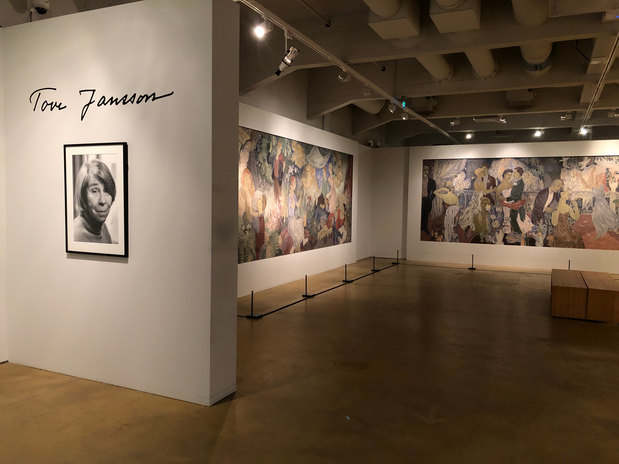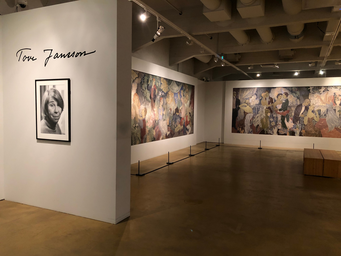To clear my head of everything else for a moment, to step outside of that figurative space cluttered with work and studies that for the life of me I cannot properly organize into neat little stacks, I visit a museum that compels the visitor to just stop and stare for a moment. A museum or a gallery space is something entirely devoted to the endeavors and artistic creations of someone else, forcing you to concentrate on form, color and then the impression the artworks give you, possibly followed by interpretations of what is presented or what and why. This is one of the ways with which I try to balance my occupied time and free time since I have no other hobbies and my social circle doesn’t exactly form a “circle” that would take my mind off things from time to time – and I’ve noticed it has become an important way for clearing my head when I might feel overwhelmed or uninspired.
Balancing things can be oddly difficult. Sure, I could make a concrete schedule and solid plans (which I do, of course), however, I can’t help but become overwhelmed sometimes. It could be because of Covid, certainly, which has put a strain on people that can make many tasks more challenging. It could also be due to high expectations generally to get things done and done properly. “This is the week I will do my best.” You do what you’re supposed to, however it might take time and effort, pouring over other obligations or moments initially of rest. But then I think “so what,” and give myself a break to not only unwind but also to let my mind rest and perhaps become inspired by something meaningful or even mundane that makes me think (like the color blue, for instance). A critical person might think that this is a form of self-sabotage – not just getting things done – and I might agree with them… if I took life that seriously. But c’est la vie, and to incorrectly repeat a cliché, life is not perfectly scheduled.
So what I did this week was I visited the Helsinki Art Museum (HAM). I generally like their spaces, and revisiting the frescoes painted by Tove Jansson, part of the museum’s permanent collection, are already worth the visit since they demonstrate the amazing skill the Moomin creator truly had. The frescoes, Party in the City (1947) and Party in the Country (1947), are delightfully inviting to the viewer, absorbing you into the colorful, celebratory spaces and the movements of the characters that show there is not a care in the world at that moment. My god, I think I envied them a little, then and there when I had to step back. These grand frescoes remind the viewer of the importance of amusement, of just letting go for a moment and thus balancing work with enjoyment.

I continued from the space dedicated to Jansson – with the frescoes as well as lovely photographs of the artist taken by her brother throughout her life – to the next galleries that are holding an exhibition dedicated to modern and contemporary Finnish artists who all have one thing in common: they have lived or are living in Lallukka, a Home of Artists in Helsinki’s Etu-Töölö district which was built in 1933.
The exhibit, named Lallukka – Life in the Home of Artists, pays homage to the creatives that have lived or are currently residing in the Artists’ Home and to the very space in which they’ve worked. The remarkable thing, then, is the fact that this is a cultural monument in Finland in which artists – painters, sculptors, actors, and musicians – still reside in. The exhibit showcases various types of artworks from the 1930s till the present day: portraits, drawings, still lifes, sceneries, abstract pieces, and sculptures – all created in the same building that is not only a creative space but also a home to many. “The idea of an artists’ home,” says HAM’s introduction, “is that people live and work under the same roof.” This made me wonder and think of how these artists would perceive “balance” and whether they would think of it as concerning their free time and working moments – whether there needs to be a balance between these two. As artists, it doesn’t seem like they would’ve cared. “Balance” between work and whatever is “free” time might even sound absurd.
This is an interesting thought to someone like me who doesn’t have a creative bone in her body. (If you were to give me, say, painting equipment, I’d only manage to paint simple flowers or tired eyes because I like flowers and have tired-looking eyes.) I’ve read many times about artists getting inspiration from their personal lives and surroundings, whether they are planning to work or not – as in, just being or resting. Or, seeing something during their “free” time that motivates them to create from their perceptions or to just experiment with form and color. For them, it probably doesn’t matter whether there is the figurative clutter (or a literal one) and if this clutter absorbs them. It could be inspired, creative clutter. Their work, then, naturally pours into their “free” time, filled with artistic inspiration already – life and work truly becoming more immersed.
I can imagine that it’s a fascinating life that doesn’t need those moments of forgetting one’s work for a while to become more “balanced.” Of course, I’m not positively sure. Artists need breaks too, but then again, would they need them to “balance” the amount of work they do and the amount of free time they spend doing something else? This question particularly brings to my mind an abstract art piece called You are with Me by Marjukka Paunila: for me, as I looked at the painting and the name, it suggests of everything immersing – the artist’s work, their view and everything in it, the surroundings creating that view and the possible figures of people, or a person (as I perceived, the figure in the top right corner). In any case, I think they’re interesting examples of people with whom life and work become more absorbed into each other.
If I had to pick a favorite, it would be Spring (Wilderness Girl) painted by Ellen Thesleff in 1935. It’s a simple, lovely portrait of a girl with little flowers in her hair and a flower between her teeth, lifting her right hand and tilting her head a bit to the left as if gesturing something or posing for the artist. It appears to depict the girl fully in the spring mood, ready for the transformation of chillier spring weather into warmer days, colored by pastel skies that change the landscape into a harmony of colors.

Funny, since our autumn just began, however we shall take a bit of inspiration from “wilderness girl” and perhaps buy ourselves some flowers and take a little walk before going back to that figurative space cluttered with work and studies.


